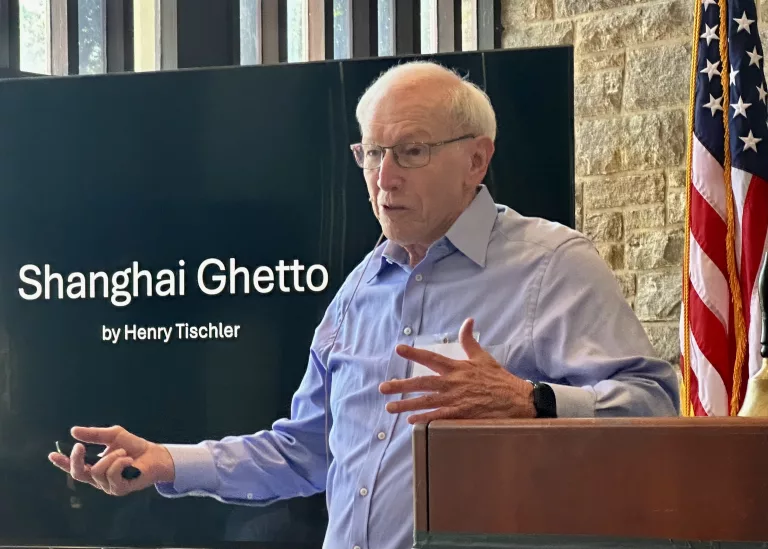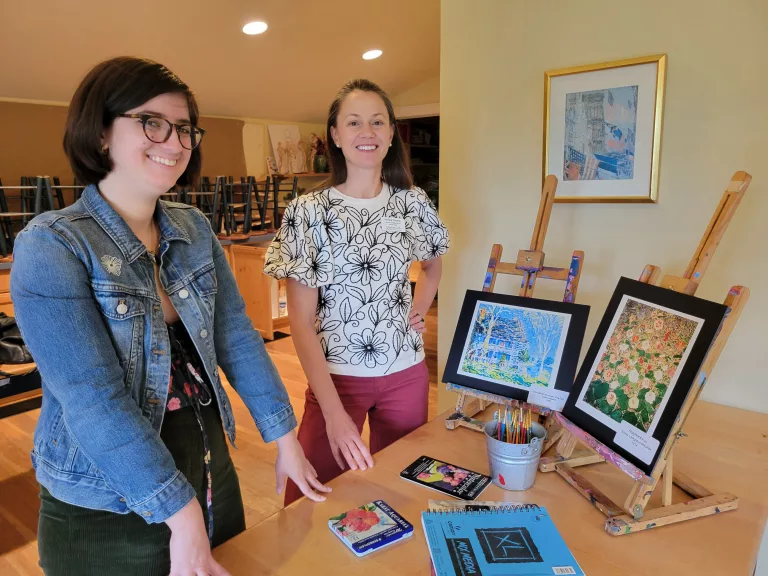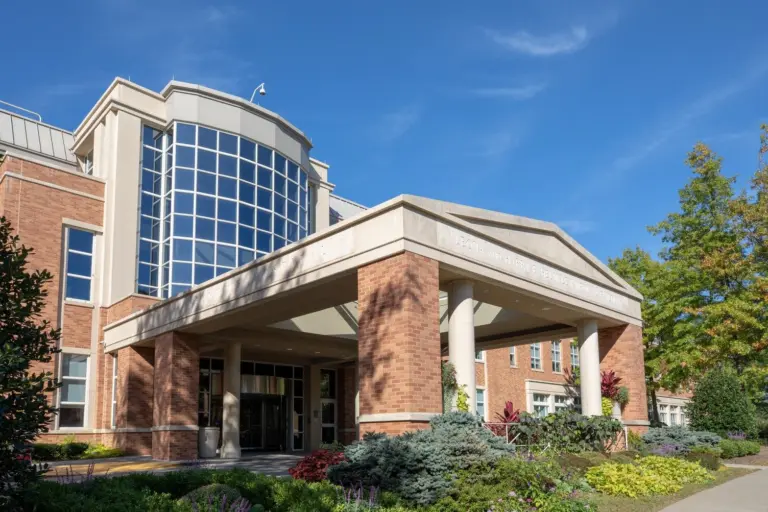By Arnold Gordon
At the July 13 meeting of the Retired Men’s Association, Dr. George Ubogy introduced the speaker, Joseph Polisi, president of the Juilliard School from 1984 to 2018. Dr. Polisi holds a Doctor of Musical Arts degree from Yale and a degree in international relations from the Fletcher School of Law and Diplomacy, Tufts University. He is currently Juilliard’s Chief China Officer, overseeing the development of The Tianjin Juilliard School.
Dr. Polisi spoke about the little known but fascinating history of the creation and operation of Lincoln Center in New York City. The full story can be found in his recent book, covering the period from 1955 through 2020, A Beacon to the World: A History of Lincoln Center. He began by explaining his exposure to music through his father, a bassoonist with the New York Philharmonic Orchestra; he became a bassoonist himself. Joseph felt that a history of Lincoln Center, which contains such distinguished representations of dance, music and drama, was important. Contrary to popular belief, Lincoln Center is not a physical entity, but a federation of 10 performing arts organizations that occupy several buildings on the 16-acre site that is sub-leased from New York City, bounded by 62nd and 70th streets, and Broadway and Amsterdam Avenue. Using 27 images from his book, he explained how it all started, evolved, and resulted in one of the major cultural locations of the world.
It began as a concept suggested in 1955 by John D. Rockefeller III, one of four brothers, who was responsible for the philanthropic activities of the family. He envisioned locating several different arts organizations in one center and an administrative entity was born over which he was president until 1961. J. D. provided $4.8 million ($50 million in today’s dollars) for the purchase of the land, which was made possible by the 1949 Federal Housing Act, which allotted federal funds for “slum clearance” in cities, with a goal of increasing the supply of quality housing. The site ultimately used for Lincoln Center displaced many minority families, yet no new housing was built on the site as a result of a controversial decision influenced by then Mayor Robert Wagner and Robert Moses. There was a strong sentiment that in the middle of the Cold War it would be beneficial to create a U.S. cultural eminence that would enrich the lives of the people and the country, at a time when the overriding spirit was military strength and prowess.
A team of distinguished architects was assembled, among them Philip Johnson (who designed the N. Y. State Theater) and Eero Saarinen (responsible for Lincoln Center Theater). Much debate took place as to whether there should be one huge building or separate structures for the different disciplines, the latter emerging victorious after much compromise on other issues. The project had such high visibility that President Eisenhower “dug the dirt” at the ground breaking. The first opening, on September 23, 1962, was of Philharmonic Hall (subsequently named Avery Fisher Hall but now David Geffen Hall). A very long concert by the New York Philharmonic led by Leonard Bernstein was attended by luminaries from all walks of life, including Jackie Kennedy representing the president. Amidst all the joy and satisfaction, a problem arose that would haunt the hall for many years, less than great acoustics! During the loud sections of the music, there were reverberations in the hall and the sound would echo. Since then, seven renovations have been made to improve the acoustics and to redesign the seating arrangements.
Openings of the other buildings and their art performances took place over the years, beginning with the New York City Ballet, founded and led by Balanchine and his partner Lincoln Kirstein. What was considered the grandest opening of all was that of the Metropolitan Opera House on September 16, 1966, the sixth building to open. In attendance, somewhat strangely, were Ferdinand and Imelda Marcos, but only because of their relationship with J. D. Rockefeller III, who was involved in U.S.-Asian politics. Life magazine referred to it as the biggest opening in history. Samuel Barber’s opera Antony and Cleopatra was performed but did not receive good reviews. However, it was her role as Cleopatra that launched Leontyne Price on her illustrious career. There are several pieces of art and sculpture (Calder, Moore, et al.) within and around the Met, including two giant murals by Chagall that were inadvertently installed in the reverse positions on the wall. Although very upset, he said he would live with it.
Initially against the wishes of the Met Opera, the New York City Opera also was given a home at the site. Soon after the Met debut, they performed Handel’s Julius Caesar, with Beverly Sills as Cleopatra. It was the start of her highly successful career. She retired from the stage in 1979 but remained very active and influential as chair of City Opera, chair of Lincoln Center, and chair of the Metropolitan Opera at various times.
Alice Tully Hall opened in September 1969. It was funded with a gift of $1.2 million by Alice, an opera singer and aviatrix from a wealthy family. The 1080 seat auditorium is the home of the Chamber Music Society of Lincoln Center and the Juilliard Orchestra. Since its opening, Tully Hall has served as a venue for numerous events, including Mostly Mozart, Great Performers, the New York Film Festivals, and Jazz at Lincoln Center, the latter first brought to the Center in 2004 through the efforts of Wynton Marsalis.
Philharmonic Hall was renamed Avery Fisher Hall in honor of philanthropist Avery Fisher, who donated $10.5 million (about $100 million today) to the orchestra in 1973. In 2015, the Hall was given its present name after David Geffen donated $100 million to Lincoln Center. The Hall is under major reconstruction with new seating arrangements for 2200 patrons and what is hoped will be great acoustics.
After a lively Q&A session, Dr. Polisi signed copies of his book, for sale at the Social Hall entrance.
For those interested in seeing the full presentation, go to the RMA website or click this link to the video: https://vimeo.com/730638500.
The RMA’s upcoming presentation “The War That Made the Roman Empire: Antony, Cleopatra, and Octavian at Actium” by Barry Strauss, Ph.D. is scheduled for 11 AM on Wednesday, July 27. After the assassination of Julius Caesar, the fate of the Roman Empire seemed to hang in the balance between two men. On one side was the battle-proven Mark Antony—Julius Caesar’s former lieutenant and the presumed next leader of the Empire—working together with Cleopatra, the Queen of Egypt, his romantic partner, and the richest and most powerful woman in the world. On the other side was Octavian—Caesar’s adopted son and chosen heir, a young and inexperienced military and political player. Both men claimed leadership of the Empire and made the case that they knew the true way forward for Rome to maintain its glory.
Historian Barry Strauss will discuss this epic struggle for power which led to one of the greatest naval battles in the ancient world as recounted in his new book, The War That Made the Roman Empire: Antony, Cleopatra, and Octavian at Actium.
Barry Strauss is a Professor of History and Classics, with a particular interest in military history, at Cornell University. He is a former chairman of its history department and a past director of Cornell’s Institute for Peace and Conflict Studies, where he studied modern engagements from Bosnia to Iraq and from Afghanistan to Europe. He is currently director as well as a founder of Cornell’s Program on Freedom and Free Societies, which investigates challenges to constitutional liberty at home and abroad.
Professor Strauss is a frequent participant in educational TV series on ancient Greece and the Roman Empire, and is the author or co-author of a dozen books, including The Battle of Salamis, The Trojan War, The Spartacus War, The Death of Caesar, The Storm Before the Storm: The Beginning of the End of the Roman Republic, and Ten Caesars: Roman Emperors from Augustus to Constantine.
To stream Dr. Strauss’s presentation at 11 AM on Wednesday, July 27, click here (https://bit.ly/30IBj21). This presentation will also be available on local public access TV Channels, Verizon FIOS channel 24 and Optimum (Cablevision) channel 79.
RMA speaker presentations are presented as a community service at no cost to in-person or Zoom attendees. The RMA urges all eligible individuals to consider becoming a member of our great organization, and thereby enjoy all the available fellowship, volunteer, and community service opportunities which the RMA offers to its members. For further information, go to www.greenwichrma.org, or contact our membership chairman (mailto:members@greenwichrma.org).





